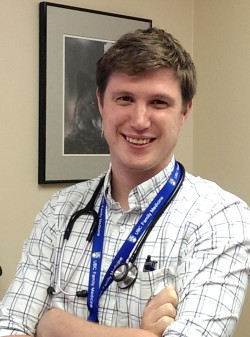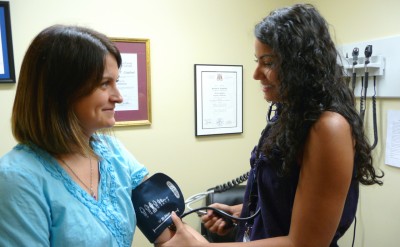
Paul Dickinson
This summer, it’s all about new beginnings for Paul Dickinson.
As a recent graduate of UBC’s Northern Medical Program, Dr. Dickinson is embarking on the next stage of his medical career, moving to B.C.’s Interior to join five other residents as part of the first cohort of UBC’s newly-launched family medicine residency in Kamloops.
“I am really excited to be part of this new site,” says Dr. Dickinson, who is busy settling in to his new home with his wife and nine-and-a-half month old son.
Over the course of the two-year residency, he and five other family medicine residents will take on a range of traditional rotations, such as psychiatry, surgery and pediatrics, in addition to family practice rotations in residential, palliative and hospital care. The program includes 19 family practice preceptors and more specialist preceptors.
“We’ve really engaged our whole community,” says Selena Lawrie, the Site Director for family medicine residency in Kamloops.
A roll-out of residency programs
The new family medicine residency in Kamloops is not the only community-based site to open its doors this summer. In July, a new five-year emergency medicine residency in Kelowna accepted its first two residents.
“Kelowna has the opportunity to become one of the premier emergency medicine training sites in the country — all the ground work is there: we have amazing facilities, great teachers, who are really excited about the program, and, being a part of the UBC umbrella, we have access to cutting-edge research,” says Kelowna emergency medicine resident Daniel Ting.
Meanwhile, on the North Shore, a new family medicine residency site accepted eight more residents.
The expansion and distribution of postgraduate training sites is part of the UBC Faculty of Medicine’s goal of increasing the number of doctors in training, and placing them in communities where they are needed most.
This year marks the tenth anniversary of the UBC MD distributed program. Expansion of UBC’s medical school to the B.C. Interior has helped increase the annual enrolment of new medical undergraduates provincially to 288 — more than double from 10 years ago. UBC’s postgraduate training programs have also steadily grown, now with over 1,400 medical trainees in 68 different postgraduate programs at more than 100 clinical training sites. This year, nearly half the residencies — a record number — are designated for family medicine, where the need is greatest.
Roger Wong, Associate Dean of Postgraduate Medical Education, sees the launch of these new residency sites in the Interior as a step in the right direction.
“We know that community needs in these areas are yet to be met,” Dr. Wong says. “We are here to step up to the plate to meet their needs.”
Filling a need
As the site director for the new emergency medicine residency in Kelowna, Kevin Clark has witnessed the need for new emergency physicians in the Interior. He hopes these residencies encourage more physicians to stay and practice in the Okanagan in the years to come – a sentiment strongly echoed by Dr. Lawrie, the Kamloops’ family medicine residency site director.
“It’s important to be training doctors throughout the province of B.C.,” says Dr. Lawrie, noting that that such programs not only help meet the needs of under-resourced communities, but provide an ideal training ground for young doctors.
For Harpreet Ghuman, the prospect of completing her family medicine residency in Kamloops holds very real benefits.
“In smaller communities there’s such a good relationship between specialists and family physicians. Everyone plays to their strengths to provide better patient care, and that’s why I went into medicine in the first place,” she says.
Having purchased a duplex in Kamloops with her partner only weeks before her residency training began, Dr. Ghuman sees the city as an attractive option for laying down roots.
“I just jumped in,” she says. “I really love the feel of Kamloops and I can definitely see myself being here long-term.”
Listening, and then helping
Dr. Dickinson first became attracted to a career in medicine while working as a summer reporter for a local newspaper — an experience that left him moved by the people he met and the stories they told, but somewhat unsettled by his inability to help community members in need.
“The thing that really attracted me to medicine is that you not only get to hear these stories about people, but you actually get to help them,” he says.
As a native of Lillooet, B.C., and with an interest in rural medicine, Dr. Dickinson is particularly excited about the smaller learning environment and family residency training opportunities in a city like Kamloops.
“Smaller-town doctors are often asked to have a broader scope of practice, and that’s a challenge that I find very exciting and that I’d like to take on,” Dr. Dickinson says.
